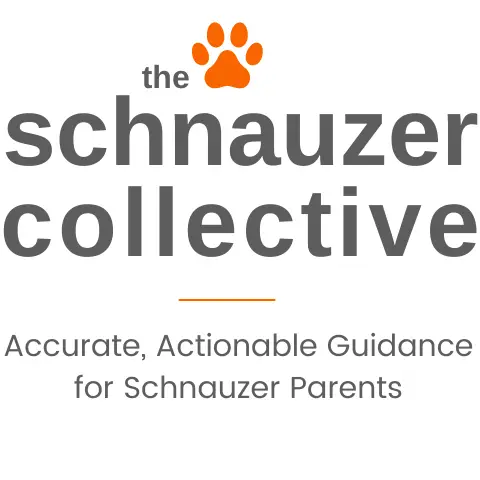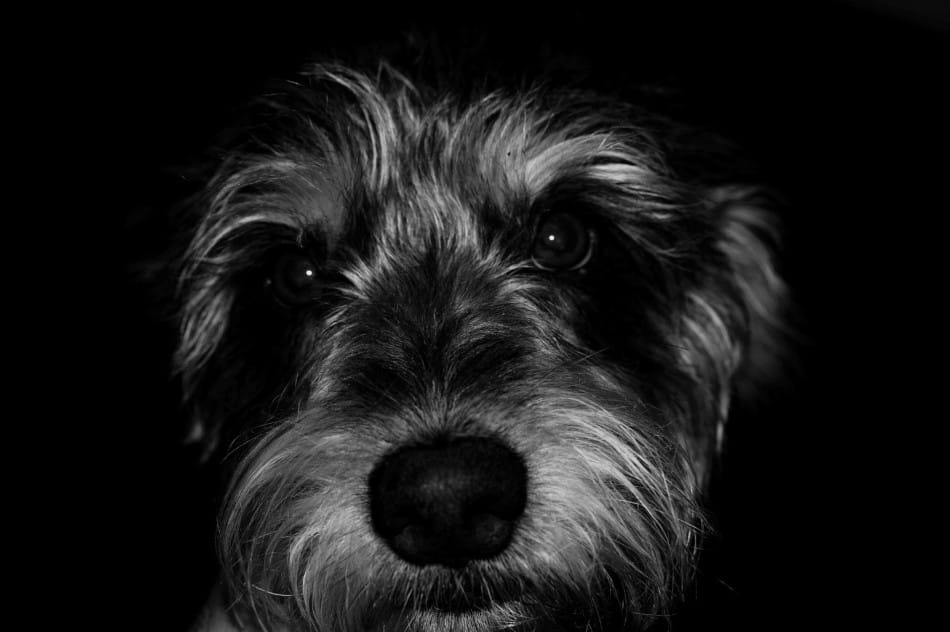When we brought our new Schnauzer puppy home, our 7-year-old son thought it would be “fun” to teach her how to open cupboards. She learned very quickly and suddenly a whole new garbage- and food-filled world opened up for her (literally). While this isn’t the best use of Schnauzer intelligence, the story is endearing to me and does beg the question: Are Schnauzers smart and how can we tell? As it turns out, there are some very specific answers to those questions.
Are Schnauzers smart? Yes, Schnauzers are very smart as far as dogs are classified, and are generally considered to have similar cognitive functioning as an average two-year-old human child. There are three categories of canine intelligence: Working/Obedience, Instinctive, and Adaptive. Schnauzers score high in each category.
In the current list of the most intelligent dogs, the Miniature Schnauzers rank in the top 12, the Standard Schnauzers rank in the top 22, and the Giant Schnauzers rank in the top 35. But what makes Schnauzers intelligent dogs?
In this article, we’ll look at how canine intelligence is measured and the factors that contribute to a dog’s IQ.
You’ll also find five at-home intelligence tests at the end. They are a fun way to do your own informal research!
Canine Intelligence Research
Dog owners, researchers, and trainers have as much trouble agreeing on a technique for testing dog intelligence as they have for human intelligence.
Generally speaking, though, the definition of intelligence is the ability to learn and obtain knowledge, and use that knowledge in productive, useful ways.
Within that working definition, there are ways to test and understand intelligence in general, as well as within specific species.
Researchers study canine intelligence in an effort to understand man’s best friend better, but also to understand intelligence in general.
Stanley Coren
The present list of the most intelligent dog breeds is largely credited to Stanley Coren, a leading canine psychologist and researcher at the University of British Columbia. In 1994, Coren worked with 199 obedience trial judges from North America in his studies, and the outcome was remarkable. Using tests originally meant to show language development, pre-language, and fundamental arithmetic in children, these researchers were able to demonstrate that the average canine is smarter than they are typically given credit.
Schnauzers are generally near the top of each intelligence measurement and that just adds a layer of fascination to our already strong bond with them.
THE SCHNAUZER COLLECTIVE
Since there were several breeds of dogs and only 199 judges, some breeds only participated in a few assessments. Only dog breeds with a minimum of 100 evaluations qualified for Dr. Coren’s intelligence list. The researchers also compiled a list of the most intelligent and the least intelligent breeds utilizing information from the obedience classes.
Professor Coren believes that many decades of selective canine breeding in addition to living with and learning from human beings has assisted in honing canine intelligence. Specifically, the activities and tasks for which dogs were bred have contributed to their current level of intelligence. For example, breeds like Schnauzers were bred to guard farms and hunt rodents. As a result, they’ve developed not only their own instinctual intelligence, but also a level of decision-making. Other breeds like Retrievers and Collies were simply bred to follow commands.
Charles Spearman
Research into canine intelligence is also used to better understand human intelligence and the concept of g factor or “general intelligence” proposed by psychologist Charles Spearman.
Spearman proposed an underlying factor of general intelligence that forms the basis for all other types of specific intelligence. His g factor is thought to be predictor of specific intellectual abilities. It’s similar to a general form of athleticism that predicts how well an “athletic” individual will perform in many specific sports and measures.
General intelligence, or g factor, is thought to be primarily a genetic inheritance, although experience can play a role as well. The fundamental belief is that an individual (or other species, such as canines) who have a high level of general intelligence do so because their nervous system processes information more quickly and retains it much better.
Recent research on canine intelligence uses several measures, including Spearman’s g factor to study intelligence in dogs as well as in humans.
Measuring Canine Intelligence
Measurements of canine intelligence fall into three categories. Each category encompasses a similar grouping of capabilities. Each category addresses fairly specific skills and abilities, although there is some overlap among the three.
In addition, just as with debates about human IQ, it is not always easy to be completely objective about how to define and quantify canine intelligence.
Even within the debate, specific categories identified by professor Cohen and an openness to an underlying g factor proposed by Charles Spearman, give us places to start.

These are the current categories that provide measurements of canine intelligence:
Working and Obedience Intelligence
Working and Obedience intelligence is close to what we would define as school-type of learning. It is essentially a dog’s ability to learn tasks and internalize instruction from humans. This type of intelligence is integral to our relationship with, and domestication of, all dog breeds. This type of intelligence is critical to a dog’s ability to perform useful tasks for humans and in securing a valued role in our lives. While we’ve grown to love dogs for their companionship, their utilitarian value has been traditionally very important.
Instinctive intelligence
Instinctive intelligence generally refers to what a specific dog breed was reared for. For instance, herding dogs are bred to herd farm animals. Their capacity to round up cows or sheep, keep them together, and even drive them along a particular path is inborn. They only need human intervention to keep them under control and also to give them direction.
Each dog breed has a unique type of instinctive intelligence. For example, guard dogs are usually bred to guard things or people; hounds track; retrievers retrieve; companion canines are attuned to the moods of human beings, and pointers sniff birds out and indicate their whereabouts by pointing.
Adaptive intelligence
The third measure of intelligence in canines is known as adaptive intelligence. This is generally an indication of what problem-solving capacity and what dogs can learn to do for themselves. Adaptive intelligence entails learning from experiences with the environment and utilizing that information to resolve new and unfamiliar problems. This kind of intelligence might vary among individual canines of a similar breed. The difference between a less intelligent and more intelligent dog of the same breed (and in intelligence differences between different breeds) is usually the level of their adaptive intelligence.
We Know That Schnauzers are Intelligent, But How Can We Tell?
The categories described above offer the benefit of not only defining canine intelligence, but also of detailing specific capabilities and skills we can use for measurement.
How Intelligent Are Miniature Schnauzers?

Miniature Schnauzers are the smallest in size among the three variations of Schnauzers. Their weight ranges between 10 to 15 pounds and has a height of approximately 11 to 14 inches. Out of the three Schnauzers, the Miniature Schnauzers performed the best in Dr. Coren’s intelligence list.
Working and Obedience Intelligence
Miniature Schnauzers were ranked the 12th most intelligent dog breed out of the 140 qualifying breeds, and were grouped in the category of bright dogs. The breeds in this category can learn a brand new command with only five to fifteen repetitions. In addition, Miniature Schnauzers can obey a common command with a success rate of 85% or better.
Instinctive Intelligence
The Mini Schnauzers were originally bred from the Standard schnauzer. These dogs were bred to hunt down rats in farms and other pests and were among the best ratters. They are no longer used as ratters generally speaking, but they still retain the mischievous and lively personality that made them incredible ratters in the past. The instinctive intelligence of these small dogs is the inherent ability to track and hunt down pests effectively.
How Intelligent Are Standard Schnauzers?

The Standard Schnauzers are the original Schnauzer breed and stand as the medium-sized variation. They are approximately 20 inches tall and weigh around 30 to 45 pounds. They rank lower than the Miniature but are still in the same intelligence level of bright dogs.
Working and Obedience Intelligence
What’s more, they are the second smartest dogs among the three Schnauzer breeds. The Standard Schnauzers have currently ranked the 22nd most intelligent dog breeds out of a total of 140 breeds. This schnauzer breed is placed in the same intelligence category as the Miniature Schnauzers because they learn quickly, and are very obedient dogs. Like Miniature Schnauzers, they can generally learn new commands within five to fifteen repetitions and perform commands with a success rate of 85% or better.
Instinctive Intelligence
The Standard Schnauzers might have the highest inherent intelligence among the three Schnauzer breeds. That is because they were reared for many things, which makes them some of the most adaptable canines. The Standard Schnauzers were initially developed to serve as multipurpose animals on farms. They were bred for ratting, guarding, hunting, and herding, among many other things. The instinctive intelligence of Standard Schnauzers is high enough to be skilled at a wide range of roles and jobs.
How Intelligent Are Giant Schnauzers?

Giant Schnauzers are both the largest and, technically, the least intelligent among the three Schnauzer breeds. With a height of 28 inches and a weight of approximately 60 to 100 pounds, these dogs are incredibly huge. Their ranking still puts them at the above average intelligence level.
Working and Obedience Intelligence
Giant Schnauzers are only one intelligence group below the Miniature and Standard Schnauzer. They rank 35th and are placed in the category of the above-average smart dogs, which means that the Giant Schnauzer can also learn new commands with around 15 to 25 repetitions, but generally only obey known commands with a success rate of 70% or better.
Instinctive Intelligence
The Giant Schnauzers are the largest breed among the three Schnauzers. Giant Schnauzers were reared to drive herds of cattle from local farms to the marketplaces. Since they are large, trainable, and loyal, Giant Schnauzers were perfect for the job. Nowadays, these dogs can work as guard dogs or as part of police or rescue forces across the globe.
The Adaptive Intelligence of All Schnauzer Breeds
The final intelligence category is Adaptive Intelligence and each Schnauzer breed performs well in this area.
Adaptive Intelligence measures how well dogs can solve problems and learn things on their own. As it turns out, all Schnauzers can easily and quickly learn things without the assistance of human beings, and have quite a high adaptive intelligence.
Examples of adaptive intelligence are remembering where treats or toys are stored, navigating through mazes, or observing you closely enough to learn how to turn off lights and open latches.
How to Keep Your Schnauzer Smart
Living with a highly intelligent dog breed like Schnauzers is fun, fascinating, and challenging. In addition to maintaining a healthy routine that includes exercise, diet, and grooming, your Schnauzer definitely needs mental stimulation.
As I mentioned earlier, I find that there is some overlap among the categories in terms of which skills and activities each intelligence addresses. As with humans, the ability to quantify intelligence is not an exact, clear-cut process.
However, in addition to your Schnauzer’s regular routine and ways of play, you could consider building in activities that attempt to directly address each of the intelligence areas Dr. Coren has identified. While Miniature, Standard, and Giant Schnauzers are already considered to be quite intelligent, why not keep a good thing going?

The following tips can strengthen and prolong your Schnauzer’s intelligence:
Enhancing Working and Obedience Intelligence
Because this type of intelligence shines when a dog is learning new and practical working skills, specific training will keep your Schnauzer’s mind and body active.
To strengthen and benefit from this type of intelligence, Schnauzers would love extra obedience training, agility training, and any new skill or trick. Again, this type of intelligence displays how well they can learn and follow commands.
In addition, you could consider specifically training your Miniature or Standard Schnauzer as therapy dogs and passing the Good Canine Citizen test. You could have your Giant Schnauzer trained as a service dog, and pass the Good Canine Citizen test as well as the Urban Canine Good Citizen Test. Read my article Can Schnauzers be Therapy or Service Dogs for more information. Your Giant Schnauzer may also love extra training as a police dog, even if he doesn’t actually serve in that capacity.
Enhancing Instinctive Intelligence
This type of intelligence capitalizes on your Schnauzer’s in-bred, instinctual capacities.
Your Giant Schnauzer would probably enjoy some type of herding training or experience. There may be a club or training in your area. There is also the option of actually becoming Herding Instinct Certified.
Your Standard and Miniature Schnauzers would instinctively enjoy Earth Dog trials which allows dogs to track and hunt underground rodents, or Barn Hunts which allows dogs to track and hunt above-ground rodents in a controlled setting. The availability and popularity of these sports will vary geographically, so check your area for availability (or start your own club!) and read my article What are the Best Sports for Schnauzers.
Enhancing Adaptive Intelligence
Adaptive Intelligence is both the foundation and capstone to canine intelligence. It defines and measures how well dogs can solve problems and learn new things without direct instruction from humans.
There are six timed at-home tests in Dr. Coren’s book that would give you a baseline for your Schnauzer’s intelligence in this category. You could also do the test described below, all of which are adaptations from Dr. Coren’s book.
Doing these tests would be a fun activity, especially if they are spaced out and repeated over time. Your Schnauzer should enjoy the mental challenge.
In addition, dog treat puzzles of increasing complexity are excellent problem-solving tests and will keep your Schnauzer’s skills sharp. Our Schnauzer, Livi, does a puzzle each morning and is working her way up to increasingly complex puzzle challenges.
Games to Test Your Schnauzer’s Intelligence
Tests in the form of “games” your Schnauzer can play are an informal, fun way to do some at-home IQ testing.
The tests below are adapted from the standard tests created by Dr. Coren.

Consider these tips before getting started on the tests:
- Do just one test per day
- Repeat the test several times per day and score the test each time
- Remember that Schnauzers tend to learn new skills in between 5 and 15 repetitions
- Remain positive throughout the testing process and keep it fun and upbeat
- These are odd requests you are making of your Schnauzer. Be patient if he seems confused at first.
- No matter how he scores, give him lots of praise
Test 1: The Blanket
Purpose: This test provides insight into your Schnauzer’s problem-solving ability.
Test: Allow your Schnauzer to sniff and become familiar with a large towel or blanket. When he is comfortable with it, place it over his head. Once comfortable, place it over your dog’s head. Time how long it takes him to take the towel or blanket off of his head.
Scoring: Give him three points if he figures out how to free himself in under 15 seconds, two points if it takes 15-30 seconds, and one point if it takes more than 30 seconds.
Test 2: The Treat Towel
Purpose: This test provides insight into your Schnauzer’s problem-solving ability.
Test: With your Schnauzer nearby, place a favorite treat on the floor and put a towel over it. Time how long it takes him to uncover the treat.
Scoring: Give him three points if he figures in under 15 seconds, two points if it takes 15-60 seconds, and one point if it takes more than 60 seconds.
Test 3: The Shell Game
Purpose: This test provides insight into how well your Schnauzer can learn and retain information.
Test: Place two or three empty buckets or cups upside down in a row on the floor. While your Schnauzer watches, place a treat under one of the containers. Distract him for a few seconds before allowing him to look for the treat.
Scoring: Give him three points if he goes straight to the container hiding the treat, two if he checks one empty container before finding the right one, and one point if he checks both wrong containers before locating the treat.
Test 4: The Paw Game
Purpose: This test highlights your Schnauzer’s reasoning and problem-solving skills.
Test: Locate a piece of furniture or household fixture (such as a gate or stair railing) that is low enough to the ground that only your dog’s paw will fit. Place a treat within his paw’s reach and time his reaction.
Scoring: Give him three points if it takes him under 1 minute to reach for the treat using only his paw. Give him two points if he tries to fit his head into the space first, or uses both his nose and paws to reach the treat. Give him one point (and maybe lots of love) if he gives up entirely.
Test 5: The Barricade
Purpose: This test reveals your Schnauzer’s reasoning and problem-solving skills.
Test: Use a large cardboard box to create a “barricade.” Use a box that is too large and high for your Schnauzer to jump over, Create a slit in the cardboard that is low enough for him to look through, but not fit through. Place a treat behind the cardboard barricade and show him the treat. Encourage him to get the treat for a total of 60 seconds and then stop encouraging him. Start timing his reaction.
Scoring: Give your Schnauzer three points if he takes 30 seconds (or less) to figure out that he needs to walk around the barrier to get the treat. Give him two points if it takes longer than 30 seconds. Give him one point of he tries to make his way through the slit or simply tries to push through the cardboard box instead of going around it.
Final IQ Scoring
These tests are meant to be fun and somewhat illuminating, and can give you and your Schnauzer further training and mental stimulation goals.
Here’s how to score:
| 13–15 Points | Stellar points for overall problem-solving, learning, and retention. Top Dog! |
| 9–12 Points | Great overall intelligence and potential. Keep working! |
| 5–8 Points | Supportive room for improvement and training. You can do it! |
| 1–4 Points | Maybe he had a bad day? Big hugs. |
While IQ definition and measurement in canines is as challenging (and controversial) a topic as it is for humans, it is absolutely intriguing. Schnauzers are generally near the top of each intelligence measurement and that just adds a layer of fascination to our already strong bond with them.
And finally, from one pet parent to another, discover my all-time favorite resources designed to cover your every Schnauzer need. I’ve done the legwork for you so you can spend more time with the people and fur friends in your life.
A portion of all profit earned on this site is donated to Pet Partners
whose mission is to improve human health and
well-being through the human-animal bond.
They train and register pets to become therapy animals,
and have local chapters in many states.

